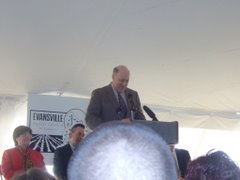(Ed. note. In preparation for tonight's Planning Commission Meeting that will conduct a public hearing on the proposed TIF #6, I have again published the article of Mr. Connors on when TIF is appropriate.)
My article in the April 26, 2006, edition of The Review discussed when the city should agree to use tax increment revenue to finance construction of infrastructure (e.g., streets, sanitary sewer mains, water mains, etc.) or provide other incentives for development and when it should not. Property owners and developers suggest the city should be willing to make such an investment whenever the proposed development will generate enough tax increment revenue over the life of the tax incremental district (TID) to pay off the amount borrowed to invest in the incentive. In my article, I suggested that the city should first ask if development at the particular location is likely to occur without an incentive. If it is likely that development would occur without the incentive, the city should not give the incentive, and it is irrelevant whether the investment in the incentive could be recovered over the life of the TID. The following illustrations might help your readers understand why I say this.
In the first illustration, assume you are the manager of a company that produces adhesive products. You have an opportunity to produce a new product, but to do so you must purchase a new machine for $1 million. Before you decided to purchase the new machine, it would be prudent for you to estimate the amount by which expected revenue from the new product would exceed expected variable production costs (e.g., raw materials and labor) each years, so you could determine how long it would take to collect enough “profit” to pay off the investment in the new machine.
In the second illustration, everything is the same as in the first illustration, except that your company already has a machine that could produce the new product with slight modifications that cost almost nothing to make, and the existing machine currently is not being used. In this situation, would you even consider purchasing a new machine for $1 million to produce the new machine? Would you care how long it would take to recover the investment in the new machine? No, you would conclude purchasing the new machine makes no sense no matter what the recovery analysis would show. Instead, you would use the existing machine, with slight modifications, to produce the new product.
The first illustration is like a proposed development that is not likely to take place unless the city uses tax increment revenue to finance construction of infrastructure or provide other incentives for development (e.g., the initial construction and subsequent expansion of the Stoughton Trailers plant, for which the city provided incentives through TID No. 4). In this situation, it would prudent to ask how long will it take for the proposed development to generate enough tax increment revenue to recover the investment in the incentive, just like it would be prudent to ask how long will it take for the new product to generate enough “profit” to recover the investment in the $1 million new machine.
The second illustration is like a proposed development that is likely to occur even if the city refuses to use tax increment to finance construction of infrastructure or provide other incentives for development. In this situation, it would not be prudent for the city to give the incentive, just as it would not be prudent to purchase the $1 million new machine when your company already has a machine that is not being used and could produce the new product with minor modifications. This is true regardless of how long it would take to generate enough tax increment revenue to recover the incentive being requested by the property owner or developer (or how long it would take to recover the investment in the new machine). It is wasteful to give a TIF development incentive or to purchase a machine that is not needed.
The southeast corner of USH 14 and CTH M, by the new traffic control lights, Piggly Wiggly, McDonalds and new Bank of Evansville, is an example of a location where it is highly likely that commercial development will occur without tax increment assistance. Consequently, it would not be prudent for the city to agree to use tax increment revenue to finance construction of infrastructure for a new commercial lot at that corner. The landowner or developer should pay for construction of the infrastructure and recover the cost through the sale of the lot to the commercial (probably retail) business that would choose to locate there. This situation is different from the Stoughton Trailers plant, an industrial facility, which likely would not have been constructed anywhere in Evansville without tax increment assistance.
Bill Connors
Evansville City Administrator
Monday, June 05, 2006
(Orig post 4-28-2006) Mr. Connors Speaks: On Use of TIF; When it is appropriate ; When it is not
Subscribe to:
Post Comments (Atom)






























No comments:
Post a Comment